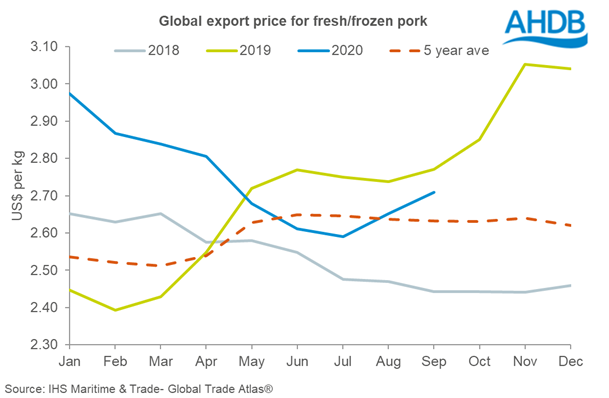



Global pork export prices rose in the third quarter
Global prices for internationally traded pork started to move higher in the third quarter after declines earlier in the yearThis is based on average export prices from the major trading regions. From the low point in July at US$2.59/kg, the average global export price reached US$2.71/kg in September. This was the highest monthly price since April and meant prices were back above the 5-year average for the time of year. However, they remained below the highs recorded in 2019, though the difference narrowed somewhat.

The extent of the uplift in pork export prices during the third quarter of the year varied across the four main exporting regions (the US, Brazil, Canada and the EU). Prices were highest for EU exports, averaging $2.99/kg in September, a 3% increase compared to July. This is a different trend to that seen in EU farmgate prices, which declined by 10% across the same three-month period. There were a number of challenges affecting the availability of product for export during the quarter, which may have played a role in supporting prices at export level. Some plants were unable to export to China for a period due to COVID-19 outbreaks amongst staff, likely supporting prices for those that were able to maintain access. Germany also discovered ASF in its wild boar herd mid-September. Constrained processing capacity also led to pigs backing up on farm in some key producers, which would only be negative for prices at farmgate level. The increase in dollar terms is also exaggerated a little by some strengthening of the euro against the dollar.
The US export price showed less movement across the third quarter, reaching just $2.42/kg in September, less than 2% more than in July. The price competitiveness of US product compared to the EU was greater than in quarter two.
Brazilian pork exports were the cheapest amongst the four main exporters, at just $2.31/kg in September, though this was up from $2.12/kg in July.
Canadian prices also rose sharply during the quarter, reaching $2.55/kg in September, 6% more than the July average.
Overall, strong Chinese import demand against a backdrop of challenges in supplying the market from the main exporters enabled the boost to export prices. This may be a continuing theme in prices during the latter portion of 2020, when data becomes available. Nonetheless, price support from export markets won’t necessarily feed through to farmgate prices, if markets remained challenged by excess volumes that cannot be exported. This is a particular challenge for the EU market of course, as Germany remains unable to access the Chinese market.









